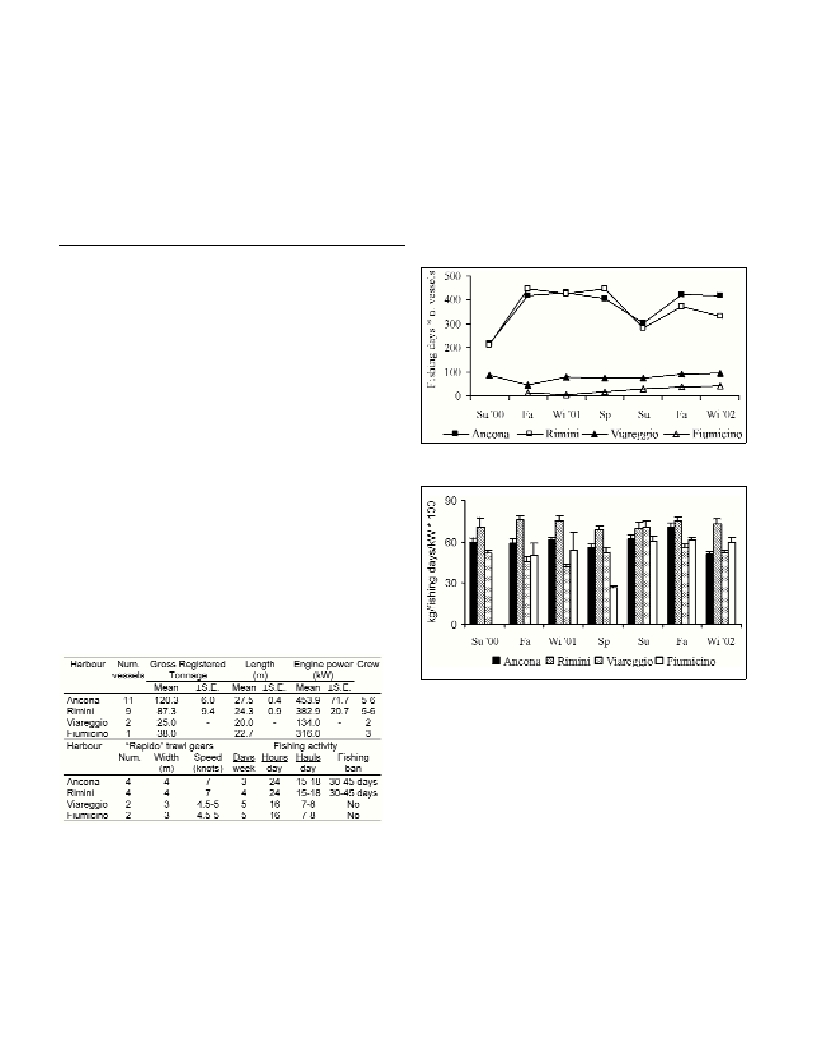FISHING CAPACITY AND FISHING ACTIVITY OF FOUR “RAPIDO” TRAWL FLEETS
ALONG THE ITALIAN COASTS
Fabi G.
1
*, Sartor P.
2
, Grati F.
1
, Carpentieri P.
3
1
CNR - Istituto Scienze Marine Sezione Pesca Marittima, Ancona, Italy - * g.fabi@ismar.cnr.it
2
Centro Interuniversitario Biologia Marina e Ecologia Applicata, Livorno, Italy - psartor@cibm.it
3 Dipartimento Biologia Animale e Uomo, Roma, Italy
Abstract
Fishing capacity and activity of four ?eets using “rapido” trawl along the Italian coasts were investigated. Consistent ?eets exist only in
the Adriatic, while this gear is scarcely employed along the western Italian coasts. Boat length, GRT, engine power, fishing activity and
total landings of the Adriatic ?eets were considerably higher than those of the western basin vessels. These differences were reduced when
landings per unit of effort are considered.
Key-words: rapido trawl, landings, fishing effort, Mediterranean Sea
Rapp. Comm. int. Mer Médit., 37,2004
351
Introduction
“Rapido” trawl is used in Italy to exploit sole and scallops. It
resembles a beam trawl and consists of an iron frame provided with
3-5 skids and a toothed bar on its lower side. Nowadays it is largely
used along the northern Adriatic coast, whereas few vessels operate
with this gear in other Italian waters. To gather information for
managing this fishery, a study on the characteristics of few Italian
?eets using “rapido” was performed funded by EU (1), paying
particular attention on fishing capacity and fishing activity.
Materials and methods
Four ?eets were considered: Ancona and Rimini (northern Adriatic
Sea), Viareggio (eastern Ligurian Sea) and Fiumicino (central
Tyrrhenian Sea). Information on the main characteristics of vessels
using “rapido” (GRT, boat length, engine power) and on fishing
activity was collected at each harbour. From July 2000 to March 2002,
data on monthly fishing days and total landings were recorded for
each boat, through logbooks, interviews with fishermen and/or
collection of auction documents.
Results and discussion
The “true” rapido fishing ?eets exist only in the northern Adriatic
Sea (Table 1), while along the western Italian coast its use, although
more important in the past (2), is negligible at present, due to the
reduced presence of suitable seabeds and to legislative restrictions
issued in 1995 and still in force. The vessels of the two Adriatic ?eets
were considerably larger, in terms of length, GRT and engine power,
than those operating in the western basin, allowing more gears of
larger size to be towed.
Table 1. Main caracteristics of the boats, the gears and the fishnig activ-
ity of the “rapido” trawl ?eets investigated. S.E. = standard error.
In the northern Adriatic Sea “rapido” is used day and night, all year
round and for 3-4 days a week, while in the eastern Ligurian and
central Tyrrhenian Seas it is employed mostly during day and more
unsteadily over the year, being alternated with otter trawl (Table 1).
These aspects explain differences in fishing activity (Fig. 1), which
ranged from 218 to 429 and from 215 and 446 fishing days at Ancona
and Rimini respectively, with the lowest values recorded in summer,
when trawling is banned for about 45days. On the other hand, it
ranged between 47 and 85 days at Viareggio and between 5 and 41 at
Fiumicino. Seasonal total landings were higher at Ancona (62-164 t)
and Rimini (65-132 t) than at Viareggio (4-10 t) and Fiumicino (1-7t).
These differences decreased when landings per unit of effort were
considered (Fig. 2): only the values of Rimini were significantly
higher (one-way ANOVA, p<0.05) than those of the other ports.
Fig. 1. Fishing activity performed by each “rapido” trawl ?eet.
Fig. 2. Landings per unit of effort of each “rapido” trawl ?eet.
References
1-Fabi G., and Sartor P., 2002. Study on the mixed-species catches of the
“rapido” trawl fishery along the Italian coasts. EU Study Contract N.
99/051, Final Report. 124 p.
2-Recasens L., and Sartor P., 1995. Analyse comparative des captures des
différents engins de pêche de fonds dans la zone littorale (<80 m de
profondeur). Rapp. Comm. int. Mer Médit., 34: 254.

